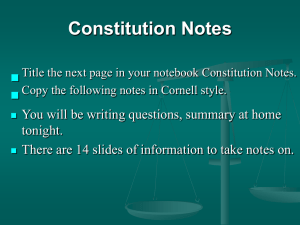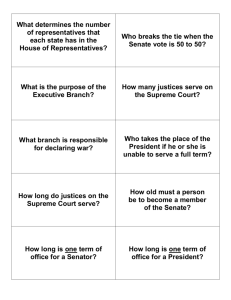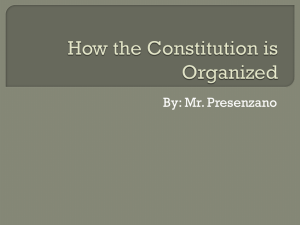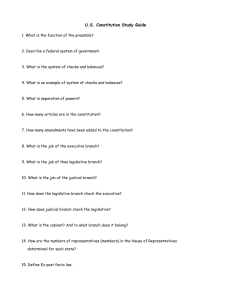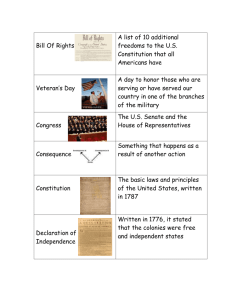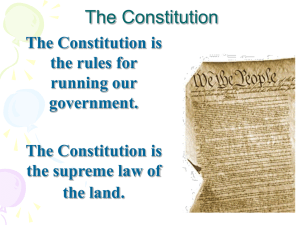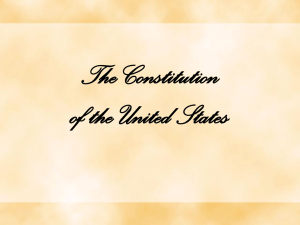PowerPoint Presentation - The American Constitution
advertisement
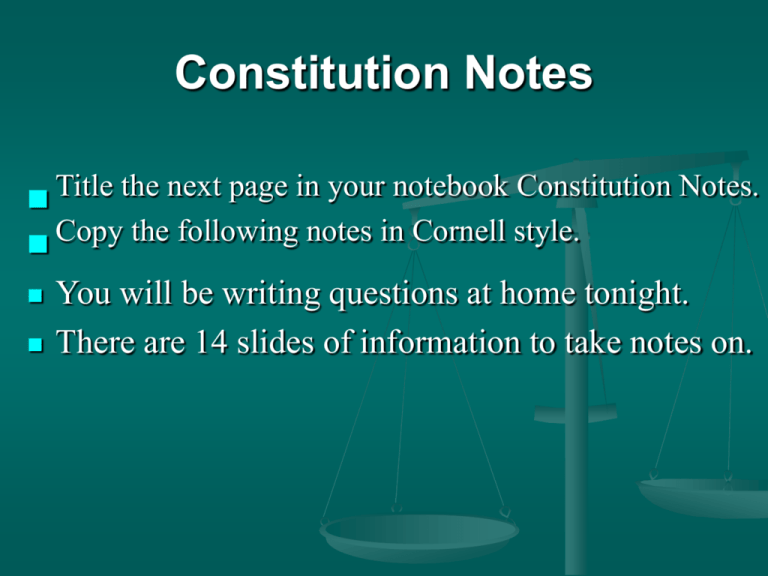
Constitution Notes Title the next page in your notebook Constitution Notes. Copy the following notes in Cornell style. You will be writing questions at home tonight. There are 14 slides of information to take notes on. The Constitution The Constitution is the supreme law of the land Preamble The introduction to the Constitution is called the Preamble. The Preamble begins with the phrase “We the people…” This means that the government is based on the consent of the people. Amendment A change in the Constitution There have been 27 amendments to the Constitution. The first 10 amendments are called the Bill of Rights. The Branches of Government There are three branches of government: 1. The legislative - which makes the laws 2. The executive - which enforces the laws or make sure the laws are carried out 3. The judicial - which interprets the laws or explains the laws and makes sure they are fair Legislative Branch The legislative branch is called Congress and is made up of two Houses (parts): The House of Representatives and the Senate. The House of Representatives States with the largest populations have the most representatives in the House. House members must be at least 25 years old or older to serve. House members are elected to a two year term. There are 435 members in the House of Representatives. The Senate The Senate is the other part of the Congress There are two senators for each state, which means of course there are 100 Senators. Senators must be at least 30 years old. Senators are elected to a six year term. The Executive Branch The executive branch is headed by the president. The president is the commander-in-chief of the armed forces. The President The president is elected to a four year term. The president can only serve two terms. The president must be a citizen by birth The president must be at least 35 years old. The Judicial Branch The Judicial Branch of the federal government is headed by the Supreme Court. Supreme Court justices are nominated by the president and approved by the Senate. There are 9 Supreme Court justices, who are appointed for life. QuickTime™ and a TIFF (Uncompressed) decompressor are needed to see this picture. Checks and Balances The framers of the Constitution established a system of checks and balances to prevent any branch government from getting too powerful. Example: Congress has the right to pass bills into law, but the president can veto them, which means the bill does not become a law. More examples If the president vetoes a law, the Congress can override his veto by a 2/3 majority. The Supreme Court can say that any law is unconstitutional. The law no longer exists. Federalism The power of government is also split between the states and the federal government. This is called Federalism. If the Constitution does not have a law, the states can do what they want. State law cannot contradict federal law. Dual Sovereignty Dual Sovereignty means that whatever the federal government does not make a law about, the states can act however they choose. That is why there is different state laws regarding the age of drinking alcohol, driving, the death penalty, and many more.
